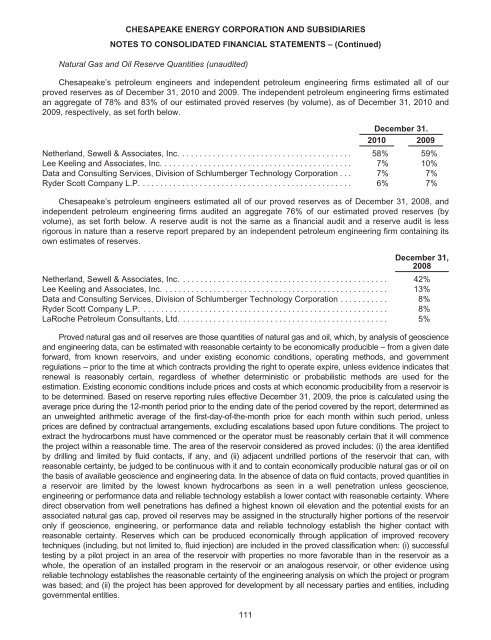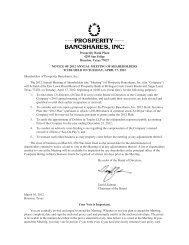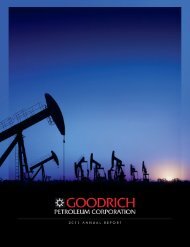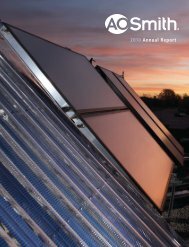6 5 - RR DONNELLEY FINANCIAL - External Home Login
6 5 - RR DONNELLEY FINANCIAL - External Home Login
6 5 - RR DONNELLEY FINANCIAL - External Home Login
Create successful ePaper yourself
Turn your PDF publications into a flip-book with our unique Google optimized e-Paper software.
CHESAPEAKE ENERGY CORPORATION AND SUBSIDIARIES<br />
NOTES TO CONSOLIDATED <strong>FINANCIAL</strong> STATEMENTS – (Continued)<br />
Natural Gas and Oil Reserve Quantities (unaudited)<br />
Chesapeake’s petroleum engineers and independent petroleum engineering firms estimated all of our<br />
proved reserves as of December 31, 2010 and 2009. The independent petroleum engineering firms estimated<br />
an aggregate of 78% and 83% of our estimated proved reserves (by volume), as of December 31, 2010 and<br />
2009, respectively, as set forth below.<br />
December 31.<br />
2010 2009<br />
Netherland, Sewell & Associates, Inc. ....................................... 58% 59%<br />
Lee Keeling and Associates, Inc. ........................................... 7% 10%<br />
Data and Consulting Services, Division of Schlumberger Technology Corporation . . . 7% 7%<br />
Ryder Scott Company L.P. ................................................ 6% 7%<br />
Chesapeake’s petroleum engineers estimated all of our proved reserves as of December 31, 2008, and<br />
independent petroleum engineering firms audited an aggregate 76% of our estimated proved reserves (by<br />
volume), as set forth below. A reserve audit is not the same as a financial audit and a reserve audit is less<br />
rigorous in nature than a reserve report prepared by an independent petroleum engineering firm containing its<br />
own estimates of reserves.<br />
Netherland, Sewell & Associates, Inc. ...............................................<br />
December 31,<br />
2008<br />
42%<br />
Lee Keeling and Associates, Inc. ................................................... 13%<br />
Data and Consulting Services, Division of Schlumberger Technology Corporation ........... 8%<br />
Ryder Scott Company L.P. ........................................................ 8%<br />
LaRoche Petroleum Consultants, Ltd. ............................................... 5%<br />
Proved natural gas and oil reserves are those quantities of natural gas and oil, which, by analysis of geoscience<br />
and engineering data, can be estimated with reasonable certainty to be economically producible – from a given date<br />
forward, from known reservoirs, and under existing economic conditions, operating methods, and government<br />
regulations – prior to the time at which contracts providing the right to operate expire, unless evidence indicates that<br />
renewal is reasonably certain, regardless of whether deterministic or probabilistic methods are used for the<br />
estimation. Existing economic conditions include prices and costs at which economic producibility from a reservoir is<br />
to be determined. Based on reserve reporting rules effective December 31, 2009, the price is calculated using the<br />
average price during the 12-month period prior to the ending date of the period covered by the report, determined as<br />
an unweighted arithmetic average of the first-day-of-the-month price for each month within such period, unless<br />
prices are defined by contractual arrangements, excluding escalations based upon future conditions. The project to<br />
extract the hydrocarbons must have commenced or the operator must be reasonably certain that it will commence<br />
the project within a reasonable time. The area of the reservoir considered as proved includes: (i) the area identified<br />
by drilling and limited by fluid contacts, if any, and (ii) adjacent undrilled portions of the reservoir that can, with<br />
reasonable certainty, be judged to be continuous with it and to contain economically producible natural gas or oil on<br />
the basis of available geoscience and engineering data. In the absence of data on fluid contacts, proved quantities in<br />
a reservoir are limited by the lowest known hydrocarbons as seen in a well penetration unless geoscience,<br />
engineering or performance data and reliable technology establish a lower contact with reasonable certainty. Where<br />
direct observation from well penetrations has defined a highest known oil elevation and the potential exists for an<br />
associated natural gas cap, proved oil reserves may be assigned in the structurally higher portions of the reservoir<br />
only if geoscience, engineering, or performance data and reliable technology establish the higher contact with<br />
reasonable certainty. Reserves which can be produced economically through application of improved recovery<br />
techniques (including, but not limited to, fluid injection) are included in the proved classification when: (i) successful<br />
testing by a pilot project in an area of the reservoir with properties no more favorable than in the reservoir as a<br />
whole, the operation of an installed program in the reservoir or an analogous reservoir, or other evidence using<br />
reliable technology establishes the reasonable certainty of the engineering analysis on which the project or program<br />
was based; and (ii) the project has been approved for development by all necessary parties and entities, including<br />
governmental entities.<br />
111











